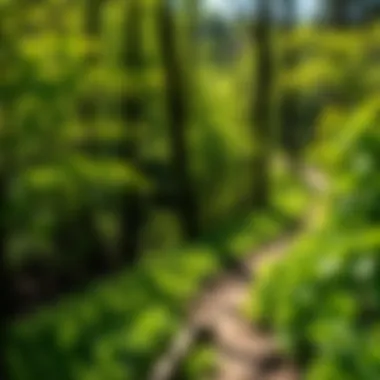Discovering the Trails of Hoosier National Forest


Intro
Hiking in the Hoosier National Forest is often a sublime experience, a tapestry woven with trails that lead through lush canopy, diverse flora, and a canvas of serene landscapes. This verdant refuge stretches across southern Indiana, beckoning adventurers with its natural beauty and varying degrees of difficulty for hikers. As you lace up your boots, understanding the forest's ecological significance and historical context adds a rich layer to your outdoor journey.
Venturing into the depths of Hoosier National Forest isn’t just about physical activity; it’s an opportunity to learn about sustainable land management and forestry practices that preserve this stunning area for future generations. This article is your guide, providing a thorough exploration of what the forest has to offer, alongside essential safety standards everyone should consider before embarking on a hike.
From those just starting out to seasoned trekkers, the diversity of trails means there's always something new to discover. However, a genuine appreciation for nature entails more than just enjoying the sights. It involves understanding the delicate balance of the ecosystems we explore. Let's begin by diving into the importance of forestry practices that protect this cherished landscape.
Understanding Hoosier National Forest
When delving into the hiking experiences in Hoosier National Forest, it is vital to first grasp the nuances of this expansive natural area. Understanding Hoosier National Forest lays a solid foundation for both novice and seasoned hikers alike, enabling them to fully appreciate the treasures within the forest. Not only is it a haven for outdoor enthusiasts, but it also serves as a critical component of the local ecosystem, cultural heritage, and recreational opportunities. This understanding shapes how we engage with the forest, encouraging responsible enjoyment of its offerings.
Geographical Overview
Hoosier National Forest is nestled in southern Indiana covering approximately 202,000 acres, encompassing a diverse landscape characterized by rolling hills, lush valleys, and extensive hardwood forests. The topography, which ranges from 500 to 1,000 feet in elevation, presents a varied terrain that impacts both the hiking experience and the ecological diversity of the area. The forest is interspersed with more than 300 miles of trails, winding through picturesque settings and offering stunning views of the region’s natural beauty.
One key feature of Hoosier National Forest is the presence of the Charles C. Deam Wilderness, which offers a more rugged hiking experience for those seeking to immerse themselves in solitude and nature’s raw beauty. Crucial waterways, like the East Fork of the White River, add to the rich geological tapestry, promoting a flourishing ecosystem teeming with flora and fauna unique to this Midwestern locale. Consequently, understanding the geographical intricacies is essential for hikers when planning their journey, ensuring safety and enhancing their overall experience in this vast woodland.
Ecological Significance
The ecological significance of Hoosier National Forest extends beyond mere aesthetics; it plays a pivotal role in supporting biodiversity, offering habitat for various species of plants and wildlife. Encompassing an impressive variety of ecosystems, the forest is home to over 400 plant species, including oak, hickory, maple, and many unique wildflowers. This variety not only contributes to the scenic landscapes but also provides vital resources for local fauna.
Additionally, the forest serves as a critical corridor for wildlife migration, delivering essential connectivity between fragmented habitats. It is not just the larger mammals—such as deer and coyotes—that thrive here, but also an abundance of smaller creatures, from amphibians to birds.
“Healthy ecosystems in our forests are a testament to our ability to coexist with nature, a lesson that Hoosier National Forest embodies.”
Understanding this ecological web not only enriches the hiking experience but also fosters a sense of stewardship among visitors, emphasizing the need to protect these precious lands. By considering the ecological dynamics at play, hikers can become ambassadors for conservation, ensuring that future generations can enjoy the beauty and benefits of Hoosier National Forest just like they do today.
Hiking Trails in Hoosier National Forest
Hoosier National Forest is a treasure trove for outdoor enthusiasts and hikers alike. Its expansive network of trails invites exploration, making it easy for both novice and seasoned adventurers to immerse themselves in nature. Hiking here isn’t merely about putting one foot in front of the other; it's an experience steeped in the lush biodiversity and serene landscapes that define the heart of Indiana.
Exploring these hiking trails offers numerous benefits. For one, the diverse environments provide opportunities for education about local ecology, including the flora and fauna that inhabit the forest. Moreover, being outdoors is known to enhance both mental and physical well-being. Since Hoosier National Forest offers trails of varying lengths and difficulties, there's truly something for everyone.
Popular Hiking Routes
Hemlock Trail
Hemlock Trail stands out with its captivating views and dense canopy of towering hemlocks. This trail winds about 2.5 miles through a serene landscape that is especially breathtaking in early summer when the leaves create a dappled effect on the forest floor. The trail is fairly easy, making it a popular choice for families and those looking to enjoy a leisurely hike.
One of the key characteristics of Hemlock Trail is its accessibility to nearby parking and amenities, which makes it a convenient option for a quick escape into nature. In addition, the tranquility of the setting allows for relaxation while strolling.
However, the trail can become crowded during peak times, which might detract from the overall experience for those seeking solitude. Still, the harmony of chirping birds and rustling leaves offers a soothing backdrop that keeps it attractive.
Grubb Ridge Trail
Grubb Ridge Trail is a favorite for trekkers wanting a moderate challenge. Spanning approximately 3.5 miles, it takes hikers through a varied terrain that offers both elevation gain and the chance to capture stunning vistas. This trail effortlessly guides visitors through gnarled roots and rocky paths, which give a taste of Indiana’s rugged beauty.
Its main attraction is the view point at the ridge where hikers can catch breathtaking sunrises or sunsets, making it an excellent choice for early risers. Not only is it popular for hiking, but it's also a great place for photographers.
The unique feature of Grubb Ridge is the diverse wildlife sightings—keep your eyes peeled for deer and a myriad of bird species. On the downside, sections of the trail can be muddy after rains, so proper footwear is advisable to ensure a comfortable trek.
Rocky Run Trail
Rocky Run Trail offers a slightly more challenging experience, making it a perfect fit for hikers with a bit more experience under their belts. This trail, around 4 miles long, features a mixture of rugged paths and smooth areas, providing a comprehensive experience of Hoosier National Forest's geological features.
What truly sets Rocky Run apart is its namesake—a gentle stream that runs alongside much of the path, providing a serene soundtrack of flowing water. Hikers often find solace sitting alongside the stream, catching their breath and enjoying the sound of nature all around.


However, adventurers should be aware that some areas can be quite steep and require caution, especially when wet. Those looking for a workout rather than a leisurely stroll will find Rocky Run Trail more than fulfilling.
Trail Difficulty Classification
Understanding trail difficulty classification is key to optimizing your hiking experience. In Hoosier National Forest, the trails are categorized into three main classes: easy, moderate, and difficult.
- Easy trails, such as Hemlock, feature gentle slopes and well-maintained paths, ideal for families and casual hikers.
- Moderate trails like Grubb Ridge involve some elevation and more rugged terrain, appealing to hikers looking for a kick of adventure.
- Difficult trails, such as Rocky Run, demand physical and mental stamina, presenting challenges that seasoned hikers typically seek.
Knowing the classifications can help hikers choose paths that align with their experience level and physical ability, ensuring a rewarding outing.
Hidden Gems and Lesser-Known Paths
While many adventurers flock to the popular trails, Hoosier National Forest is dotted with hidden gems waiting to be discovered. Lesser-known paths often provide a more intimate experience with nature, with fewer footprints along the way. Some of these include short loops that lead to secluded vistas or quiet streams. Seeking out these trails can give hikers a deeper appreciation of the forest's ecosystem, away from the hustle and bustle often found on the more traveled paths.
Biodiversity and Flora
Biodiversity and flora play crucial roles in the ecosystem of Hoosier National Forest, hosting a treasure trove of life forms that contribute to the ecological balance. The diversity of plant species creates habitats for wildlife, promoting interactions that are essential for survival and propagation. Hiking through these trails, one may come across various trees, shrubs, and flowers that thrive only in this specific environment. Each species has its own function, whether it’s providing food, shelter, or even purifying the air we breathe. The intricate web of life here reflects nature's resilience and its ability to adapt over time.
Native Plant Species
Hoosier National Forest features a rich array of native plant species, each adding character to the landscape. Trees such as the Yellowwood, Sugar Maple, and White Oak form the forest canopy, offering shade and a habitat for countless forest dwellers. Beneath the canopy, one can find lush understory plants like Redbud and Wild Ginger, which not only enhance the aesthetic appeal but also play roles in the local ecosystem.
The presence of wildflowers such as Trillium and Bloodroot during springtime creates a vibrant tapestry of color, while grasses like Little Bluestem provide cover for smaller animals. Generally, these native species are adapted to the soil and climate, which means they require less maintenance and are more resilient to pests and diseases. They also capture carbon more effectively than non-native counterparts, showcasing the critical role of local vegetation in climate balance.
Biodiversity fuels our ecosystem; it’s a symbiotic relationship where each plant and animal contributes to the health of the forest.
Wildlife Encounters
The array of wildlife found in Hoosier National Forest is a direct reflection of its unique flora. Each hike presents opportunities for memorable wildlife encounters. From the rustle of leaves as a family of deer grazes near the trail to the distant call of a turkey, the sounds of the forest are alive. Notably, the park boasts populations of Eastern Wild Turkey, Red-tailed Hawks, and even the occasionally spotted Bobcat, each of which relies on the diversity of plant life for sustenance and habitat.
Whether you are lucky enough to witness a Black Bear in the distance or catch a glimpse of a playful Fox, the flora not only nourishes these creatures but plays a vital role in their existence.
Being mindful of the wildlife is essential. Remaining quiet and respecting their space ensures that both the animals and visitors coexist harmoniously. Plentiful opportunities for bird watching also exist, with various migratory species passing through depending on the season. The rich biodiversity within this forest reflects its importance as a sanctuary for wildlife, contributing to an interconnected and thriving ecosystem.
With every step along the trails, hikers have a front-row seat to nature's complex choreography, revealing how essential biodiversity and flora are in maintaining the health and vibrancy of Hoosier National Forest.
Safety Considerations While Hiking
When stepping into the vast, inviting trails of Hoosier National Forest, it’s crucial to keep in mind that nature is as unpredictable as it is beautiful. Understanding safety considerations not only ensures a pleasurable experience but also prepares hikers for challenges that may arise on the path. This segment evaluates the key elements of hiking safety, emphasizing preparation, navigation, and wildlife education, equipping adventurers with the knowledge they need to tread confidently.
Essential Gear and Preparation
Before embarking on any hike, packing the right gear can be the difference between a triumphant adventure and an unexpected trip to the emergency room. Let’s break down some essential items:
- Footwear: Proper hiking boots or shoes are essential; they provide traction and support. Make sure they are broken in to avoid blisters.
- Clothing: Dress in layers to adapt to the ever-changing weather. Choose moisture-wicking fabrics that keep you dry.
- Backpack: A good backpack is not just for carrying snacks. It should accommodate your essentials such as water, food, maps, and a first aid kit.
- Navigation Tools: A reliable map of Hoosier National Forest, a compass, or GPS device can guide you away from getting lost. Digital hikes might see you rely on smartphone applications, but always have a hard copy of a map.
- Emergency Kit: This includes a whistle, flashlight, multi-tool, and extra batteries. It’s worth its weight in gold during unexpected setbacks.
Being well-prepared reduces anxiety and boosts confidence, letting nature show its wonders instead of overwhelming you with worry.
Navigation and Trail Marking
Understanding the layout of trails is crucial when wandering through Hoosier National Forest. The network of trails is extensive, which can lead to a sense of disorientation if proper navigation measures aren’t in place. Here’s what to consider:
- Trail Markers: Pay attention to trail markers that often consist of colored blazes on trees. Each color typically represents a specific trail. Getting familiar with the color-coded system before hitting the trails can keep you on the right path.
- Maps and Apps: Download any available maps for offline use. Several hiking apps may offer trail maps with user reviews, which can provide insights into current trail conditions.
- Group Hiking: Hiking with a group can be safer, as you can rely on each other for navigation. Plus, it adds a social aspect to your hike.
Understanding the trail system is akin to learning the rules of a game; it immerses you in the experience while preventing unnecessary hardships.
Wildlife Safety Tips


With an array of creatures that call the forest home, knowledge about local wildlife is vital. Though encounters with animals can be thrilling, they can quickly turn sour if one isn’t cautious. Some essential practices include:
- Stay Calm: If you encounter a wild animal, remain calm and try to back away slowly. Sudden movements can provoke aggressive behavior.
- Understand the Wildlife: Learn about common animals in the area such as deer, snakes, and bears. Knowing how they react can guide your actions.
- Food Storage: Keep food in sealed bags and avoid leaving scraps on the trails. Unattended food attracts bears and other wildlife, putting both you and the animals at risk.
- Bear Spray: In regions known for bear activity, carrying bear spray can be wise. Ensure you understand how to use it before heading out.
"The best defence against wildlife encounters is respect. Understanding their space is essential for both your safety and theirs."
In summary, keeping safety at the forefront of your hiking experience enhances your enjoyment of Hoosier National Forest's scenic beauty — transforming potential hazards into mere stepping stones along your path. Embrace these precautions, and you’ll forge a deeper connection with the ecosystem around you, paving the way for countless adventures.
Historical Context of Hoosier National Forest
The rich tapestry of Hoosier National Forest's history offers invaluable insights into the land we explore today. Understanding its past is not just a matter of curiosity but also a key to appreciating its current ecological significance and how we respect and interact with this cherished land. This section will unravel the cultural importance and how recreational development has changed over time, inviting the reader to consider not just where they hike, but why these trails exist today.
Cultural Significance
Hoosier National Forest has a profound cultural heritage, tied to both Indigenous peoples and European settlers. Before the arrival of settlers, Native American tribes thrived here, utilizing the forest's resources for sustenance and spiritual connection. Today, remnants of their presence can still be felt in ceremonial sites and stories passed down through generations. A visit to specific areas serves as a reminder of the relationship these communities had with the land.
European settlers in the late 19th century brought new influences, impacting both the landscape and the culture of the region. They cleared vast swathes of forest for agriculture and timber, wrestling with the land’s inherent wilderness and altering its natural course. This clash brought about a unique culture that blended agrarian life with the natural beauty surrounding it. The forest became a backdrop for early life in southern Indiana, shaping local customs and traditions.
To understand the Hoosier National Forest today, one must recognize these cultural layers that still influence the community around it, creating a tapestry that is both rich and diverse. Trails often named after local history evoke stories of the past, from pioneers to the naturalists who sought to preserve the very essence of the land they loved.
Recreational Development Over Time
Initially, the forest served as a place of solitude and resource for early inhabitants. However, as time moved on, so did the understanding of its value. The establishment of Hoosier National Forest in 1936 marked a significant turning point. It transformed from a largely agricultural landscape into a protected space aimed at conservation and recreation.
Over the decades, hiking and outdoor activities began to thrive here. The development of trails responded to the growing appreciation for nature, leading to some of the first organized hiking events in the region. The Civilian Conservation Corps played a crucial role in shaping trails and building facilities in the 1930s, enabling people to connect more deeply with the landscape.
Today, the forest boasts an extensive network of well-maintained hiking trails for various skill levels. Each path tells a story, from the rugged Rocky Run Trail challenging experienced hikers to scenic loops like the Hemlock Trail, which welcomes newcomers. The evolution from sparsely marked paths to improved amenities reflects our collective growing respect for the environment and desire for recreational opportunities.
In summary, the historical context of Hoosier National Forest reveals a dynamic interplay between humans and nature. It cultivates a deeper appreciation not only for the rich heritage of the area but also for our ongoing role in its stewardship.
"To walk in the forest is to commune with the past, the present, and the future all at once."
For further information on historical events relevant to Hoosier National Forest, visit Wikipedia or check Britannica for detailed articles.
Environmental Stewardship
Environmental stewardship is more than just a buzzword tossed around in conservation discussions. It embodies the principle of responsible management of the environment that surrounds us. In the context of Hoosier National Forest, this concept becomes significantly relevant. The area's lush landscapes, diverse ecosystems, and cultural heritage require thoughtful practices to ensure sustainability and preservation for future generations.
The importance of environmental stewardship in Hoosier National Forest largely ties into its ecological integrity. These woodlands are home to varied plant and animal species, some of which are endemic. This biodiversity is essential for maintaining the balance of the ecosystem. Promoting stewardship means recognizing the intrinsic value of these natural resources and ensuring their protection. Moreover, forest health plays a significant role in water quality, soil stabilization, and carbon sequestration, which underscores the interdependence between a healthy environment and human wellbeing.
Ensuring a sustainable hiking experience revolves around certain best practices that hikers, wildlife enthusiasts, and nature lovers can adopt. Here’s where we start seeing the crux of personal responsibility as it pertains to environmental stewardship:
- Leave No Trace: Hikers should practice the seven principles of Leave No Trace, which advocate minimal impact on the environment. This is as simple as getting rid of trash responsibly and staying on designated trails to prevent soil erosion and plant damage.
- Engage in Cleanups: Participating in or organizing cleanup events within the forest helps enhance its beauty and protects the habitats of countless species.
- Educate Yourself and Others: Taking the time to learn about the forest's ecology and sharing this knowledge contributes to a greater community awareness and fosters an ethic of conservation.
Each of these practices contributes a piece to the larger mosaic of environmental health, assisting ecosystems to withstand the pressures of human activity. Hikers are not just transient visitors; they can become stewards when they actively engage in protecting this precious resource.
"The land is not an inheritance from our ancestors, but a loan from our children."
— Native American Proverb
Sustainable Hiking Practices
Sustainable hiking practices are actions that foster a positive relationship between outdoor enthusiasts and the environment. Implementing these practices not only enhances the experience for the hiker but ensures the longevity of the trails and surroundings.
Here are a few key sustainable practices:
- Choose Appropriate Trails: Selecting well-maintained trails reduces the impact on delicate ecosystems. It’s best to stick to established paths, which minimizes habitat disruption.
- Use Eco-Friendly Products: When hiking, consider using biodegradable products. Pack out whatever you pack in, including food wrappers and hygiene products.
- Be Mindful of Wildlife: Observing wildlife is a common motivation for hiking. Keeping a safe distance and not feeding animals is crucial. This ensures that animals retain their natural behaviors and reduces stress on local populations.
Fostering a sustainable hiking experience revolves around awareness and taking decisive action, knowing that even individual efforts can lead to a collective benefit ensuring the forest sees many more seasons.


Conservation Efforts in the Forest
Conservation efforts in Hoosier National Forest are paramount to maintaining its rich biodiversity and ecological balance. Various organizations, both governmental and non-governmental, come together to enact and promote initiatives aimed at protecting this natural treasure.
Some significant conservation efforts include:
- Restoration Programs: Restoration projects focus on reviving degraded habitats and the reintroduction of native species. These initiatives often involve collaboration between local communities and conservation groups.
- Educational Workshops: These are aimed at informing the public about the importance of preserving natural resources. Workshops can cover topics such as sustainable practices, invasive species management, and the impact of climate change on local ecosystems.
- Wildlife Protection: Specific programs are designed to monitor and protect vulnerable animal species. This includes habitat restoration and population tracking.
In essence, conservation efforts ensure that the Hoosier National Forest remains a vibrant ecosystem and a sanctuary for both flora and fauna. They reinforce the notion that preservation is a shared responsibility. Every hiker walks among the trees has a role in supporting these initiatives, contributing to the legacy of Hoosier National Forest for future generations.
To further explore more about these important topics, resources like the National Park Service website or Hoosier National Forest’s official page provide nuanced details on current conservation projects and how individuals can participate.
Planning Your Visit
Planning a trip to Hoosier National Forest is not just about packing a backpack and hitting the trails; it’s a blend of understanding the landscape, the best times to visit, and how to navigate the area efficiently. By preparing well, hikers can make the most of their experience, ensuring they enjoy everything from peaceful strolls through trees to challenging climbs.
Before setting out, it's essential to consider the timing of your visit. This affects not only the weather conditions but also the natural beauty of the forest. The seasons have their distinct charm and challenges. By knowing the specifics, hikers can tailor their journeys to match their preferences, whether that means enjoying spring blooms or vibrant autumn foliage. This helps to make the experience more rewarding.
Moreover, understanding access points and facilities is critical. The forest spans more than 200,000 acres, which can be somewhat overwhelming. Not all entrances are created equal, and the amenities available at different access points can vary significantly. This knowledge helps hikers identify where to park, what facilities are available, and which trails are most accessible.
In summary, effective planning ensures safety, maximizes enjoyment, and fosters an appreciation for the intricate web of life within Hoosier National Forest.
Best Seasons for Hiking
When contemplating hiking in Hoosier National Forest, the changing seasons bring unique experiences and challenges.
- Spring (March to May): A fresh awakening as wildflowers bloom. This is typically a slower time for hikers, with cooler temperatures making it comfortable for long treks. The foliage isn't too thick yet, so wildlife is more visible. However, spring rains can create muddy trails, so waterproof boots are highly recommended.
- Summer (June to August): This is peak hiking season. The trails are flooded with visitors, and temperatures soar. Those aiming for extensive hikes should head out early in the day to beat the heat. Also, the dense green canopy provides excellent shade, although hydration becomes crucial.
- Autumn (September to November): Famous for its stunning autumn colors, this season beckons many hikers. The weather is usually mild, making it pleasant for longer hikes. This is also when wildlife begins to prepare for winter, offering a different perspective of nature.
- Winter (December to February): The forest can be stark and quiet during this time. Snow-blanketed trails become perfect for solitude. However, one must be equipped for icy conditions and the potential for sudden weather shifts, making safety gear a necessity.
In essence, each season offers its unique flavor, significantly impacting the trail experience.
Access Points and Facilities
Navigating Hoosier National Forest requires understanding where to enter and what resources lie within. The main access points include:
- Brown County Trailhead: This spot is excellent for beginners; it offers well-marked trails and parking facilities. Additionally, restrooms are provided, making it a comfortable starting point.
- Sycamore Trailhead: Accessed near the northern part of the forest, this point provides links to both easy and moderate trails. There generally are no restroom facilities, so planning ahead is wise.
- Cloverdale Interpretive Center: This is more than just a trailhead; it's a spot where visitors can learn about the ecosystem. Facilities include public restrooms and a small visitor center that provides maps and information.
In terms of facilities, keep in mind that while some areas have restrooms and picnic spots, others may lack infrastructure. It's essential to plan your trip accordingly, ensuring you have enough supplies, including water and snacks, especially when venturing into remote areas.
Knowing these access points and their facilities mitigates the risk of wandering into less familiar territory without adequate resources.
Further Resources
When venturing into the scenic trails of Hoosier National Forest, having the right information at your fingertips can make all the difference. The category of Further Resources serves as a vital conduit for hikers, whether they are seasoned explorers or new to the great outdoors. These resources enhance understanding and preparation, ensuring that your walking experience is safe, enjoyable, and materially enriched.
Additional Reading and Guides
A plethora of guidebooks and online resources exist to deepen your knowledge about the forest trails. Many individuals find that diving into literature, whether from libraries or online eBook platforms, can significantly enrich their hiking experience. Here are a few notable sources worth considering:
- Trail and Terrain Guides: Books and pamphlets specifically covering Hoosier National Forest trails offer detailed maps, elevation profiles, and insights on flora and fauna. Check resources like Purdue University’s Department of Forestry and Natural Resources for specialized information about local ecosystems.
- Online Hiking Platforms: Websites such as AllTrails or Hiking Project provide user-generated content, featuring trail updates, conditions, and reviews. This can be particularly handy for selecting a trail that fits your skill level or interests.
- Local Conservation Organizations: Groups such as the Hoosier National Forest Association often publish reports and educational materials that help shed light on ongoing conservation efforts and provide historical context about the area.
Incorporating a range of readings enables hikers to go beyond trails, exploring the environmental significance and historical perspective of the land they tread on. A more informed hiker also fosters a greater connection to the environment.
Connecting with the Hiking Community
Hiking isn’t just about solitary walks; it’s also about the shared experiences that deepen our appreciation for nature. Engaging with other hiking enthusiasts through community forums and local meetups can further enhance your trekking ventures. Here are some avenues to consider:
- Social Media Groups: Platforms like Facebook and Reddit host various groups dedicated to hiking in Hoosier National Forest. Here, enthusiasts share tips, trail conditions, and local events that can help you plan your visit more effectively.
- Local Hiking Clubs: Joining a hiking club can facilitate connections with like-minded individuals. Often, these clubs organize group outings, educational workshops, and conservation projects, providing you with opportunities to learn more while giving back to the community.
- Volunteer Programs: Some organizations offer volunteer days focused on trail maintenance and ecological restoration. Participating in these programs not only connects you with fellow hiking lovers, but it also contributes positively to preserving the trails you enjoy.
Remember: hiking is as much about movement as it is about community. Engaging with others who share your passion can lead to shared wisdom and new adventures.
"In every walk with nature, one receives far more than he seeks." - John Muir
Whether you are hiking solo or in a group, having the right resources readily available is invaluable. By tapping into the wealth of information available, you not only enhance your personal experience but also contribute to a wider culture of wilderness appreciation and responsibility.















